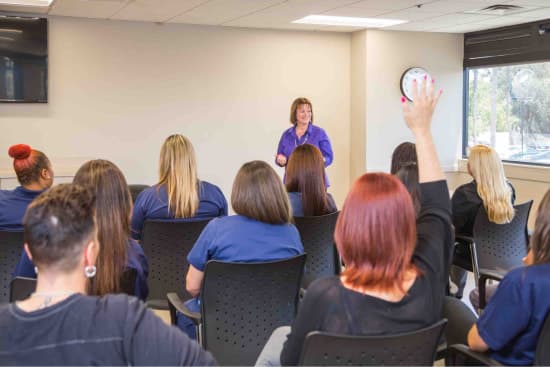Southern California Drug and Alcohol Rehab
Drug Abuse and Addiction Treatment in Southern California
When it comes to addiction treatment finding the right drug rehab can make recovery possible. The informational guide to Laguna's treatment programs explains the process and makes the system of care easier to comprehend.
California Addiction Statistics

Drug abuse and addiction impacts millions of people each year. According to a 2018 report from the California Health Care Foundation, about 8% of Californians suffer from substance use disorders, but sadly only about 10% of those receive any kind of professional treatment.1
In California, young adults are severely impacted. Substance use disorders were most prevalent among young adults 18 to 25, occurring at nearly twice the state average rate.1
Unfortunately, untreated problems with substance use can have disastrous consequences for Californians. Consider the fact in just Los Angeles County alone, there are nearly 3,000 deaths related to alcohol and other drug use (AOD) and more than 132,000 AOD-related ED visits.2
Opioid abuse, in particular, continues to bring suffering to Californians. The follow statistics provide a brief snapshot of the problem:
- In 2018 in California, close to half of all overdose deaths (45%) involved opioids.3
- The opioid overdose death rate for Orange County is higher than the statewide rate.4
- Seven out of every 10 drug-related deaths in Orange County involve opioids, and more than 80% are accidental. 4
- The number of heroin-related ED visits more than tripled between 2006 and 2017 in California.1
- Nearly 1.5 million opioid prescriptions were dispensed to Orange County residents in 2018.4
- In 2018, the Orange County Sheriff’s Department administered 58 doses of Narcan (the opioid overdose reversal drug) to overdosing individuals, which represents a nearly 60% increase from the year before.
Southern California Harm Reduction Services

Southern California residents have numerous options for substance abuse treatment and services. From harm reduction organizations to help drug users prevent deadly overdose and disease transmission to safe drug disposal locations to free HIV testing sites, there are many avenues to drug users and their families to find assistance in Southern California.
For those struggling with opioid abuse, and for those who are worried about them, having naloxone (Narcan) on hand is critical. Naloxone can quickly and effectively reverse the effects of an overdose on heroin or painkillers.
California Drug & Alcohol FAQs

Addiction Treatment in Southern California

Southern California is home to famous cities and counties like Los Angeles, San Diego, Hollywood, Anaheim, Riverside, San Bernardino, and more. In the state of California, drug and alcohol rehab services in Orange County are overseen by regional county health departments under the larger umbrella of the California Department of Health.
Each individual county health department supports residents by contracting with local addiction and mental health treatment service providers. For example, the Los Angeles County Department of Mental Health has contracts with more than 1,000 treatment providers in the local vicinity. The Behavioral Health Services (BHS) division of the San Diego County Health and Human Services Agency manages community providers and local care in San Diego County. Each specific county in California has their own regional entity that manages behavioral health services.
Addiction Treatment at Laguna
Laguna Treatment Center’s location near San Diego and near Los Angeles makes it easy for native Californians and out-of-staters to access our treatment programs. Our Orange County detox and addiction treatment team is made up of medical and clinical staff that continuously work to provide the highest quality of care.
Our levels of care include:
Medical Detox. Medical detox involves around-the-clock care, access to addiction specialists, and the as-needed use of medications—all of which help ensure the process is as safe and comfortable as possible.
Inpatient Rehab. With inpatient or residential treatment, you’ll stay at the facility 24/7. Many people find that undergoing residential rehab helps them gain the skills they need to remain in long-term recovery.
Aftercare. Aftercare programs will be different for everyone. Most rehab programs, including Laguna Treatment Center, offer aftercare planning services while the patient is in treatment so that they have a smooth transition once their program is complete.
Specialized Addiction Treatment Programs
Veteran and First Responder Addiction Treatment. Laguna’s Veterans program is a specialized addiction treatment program for military Veterans from all branches of the U.S. Armed Forces, as well as current and retired first responders.
Types of Addiction Treatment in California
The most comprehensive format of care is an inpatient drug and alcohol rehab program. These programs can offer care and support 24/7, maintain strict schedules, and provide the highest level of care available. In an inpatient drug rehab program, a person will remain in a secure and safe facility that provides an encouraging and supportive environment for healing.
The National Institute on Drug Abuse (NIDA) recommends that a person participate in a drug rehab program for at least 90 days. An inpatient drug rehab program can provide a person the opportunity to fully reset, allowing time to heal and build healthy habits and life skills. A daily schedule may include: group and individual therapy sessions, stress management and relapse prevention training, life skills workshops, support group meetings, drug abuse education programs, nutritional planning, exercise, recreational and fitness opportunities, and more. Treatment for additional or co-occurring mental health and medical disorders can also be provided, and medications can be properly managed.
Detox is often a component of a drug rehab program that may need to come first. Detox allows drugs to process out of the body in a safe and supportive environment. Medical detox for alcohol and drug addiction provides around-the-clock medical care and mental health support. It may involve the use of medications to manage difficult withdrawal symptoms and drug cravings that can occur. After detox is complete, within about a week or so, a person should then enter directly into a drug rehab program.
A step down from an inpatient drug rehab program is a partial hospitalization program, or PHP. A PHP may be a transitional program as a step down from an inpatient program or as a step up from a traditional outpatient drug rehab program. PHPs are generally structured similarly to an inpatient drug rehab program with strict schedules for several hours each day; the main difference being that a person will return home each evening and not remain on site.
Another form of outpatient drug rehab is an intensive outpatient program, or IOP. These programs offer services for a minimum of three hours each day for at least three days each week. The services can be scheduled to fit within a person’s other obligations, such as school, work, or family duties. IOPs and PHPs are typically short-term drug rehab programs and often transitional in nature, serving as in-between options from inpatient to traditional outpatient care. A traditional outpatient drug rehab program can offer a wide range of treatment services scheduled at a person’s convenience.
Support groups are often an important aspect of any drug rehab program. They can provide help with relapse prevention, sober fellowship, and ongoing peer support and mentorship. Outpatient programs require a supportive home life and family situation. Inpatient drug rehab programs can offer the highest standard of care and the most options and services.
Beyond drug rehab formats, there is also a difference in providers in Southern California. The biggest thing to be aware of are the two main types of drug rehab providers: public versus private providers. A private provider offers services that are considered to be fee-based, and often, health insurance coverage can help pay for treatment. Private providers typically have more options to choose from, more luxurious and private surroundings, and added amenities.
Public drug rehab options can be offered free of charge or for a low cost to individuals in need. Eligibility is typically based on household income level. Priority for public drug rehab programs in Southern California will go first to pregnant women and people with families and then to those with financial hardship who are in immediate crisis. Funded through state and federal money and grants, public programs often have waiting lists and may not be as immediately accessible as a private drug rehab program.
Throughout the United States, NIDA publishes that there are more than 14,500 specialty drug rehab programs to choose from. Each provider will offer a range of services and treatment options and varying levels of care.
When deciding on a drug rehab program for a loved one in Southern California, it is important to understand what exactly is needed. For instance, a person who struggles with addiction involving more than one substance, who also battles a mental health disorder, or who is significantly dependent on drugs will likely need to begin with a medical detox program that can transition into an inpatient rehab program. Programs that offer seamless transitions between levels of care can be helpful, too.
A full drug use, mental health, and medical assessment should be done prior to enrollment in any program in order to define exactly what a person may need. Assessments should also be done regularly throughout treatment as needs can change over time. Drug rehab programs should offer a full continuum of care with a wide range of services and options to suit your family’s needs.
Families play a big role in drug addiction treatment and recovery. It can be beneficial to choose a provider that is conveniently located so loved ones can visit and attend family sessions as needed.
Cost is also a factor. A budget should be worked out to determine how treatment payment can be arranged prior to enrollment in a program. Drug treatment providers will vary in terms of costs and payment arrangements. Faculties can often work directly with insurance companies to maximize coverage. They may also provide flexible payment options and plans to fit a family’s budget.
NIDA reports that addiction treatment can save families and society money down the line. In fact, treatment might save as much as $12 for every dollar spent when taking into account healthcare costs, lost workplace production expenses, and legal and criminal fees.
At Laguna Treatment Center in Orange County, CA, you’ll receive the highest standard of care from our medical and clinical staff. Our team has years of experience providing care, compassion, and evidence-based treatment for addiction and co-occurring mental health disorders. If you are struggling with addiction and looking for rehab in Orange County
Detox & Rehab: What to Know
Rehab FAQs for Patients
Find answers to common questions patients have about attending rehab, as well as FAQs from patients' family members and loved ones and a list of general questions associated with treatment.
Getting to Laguna Treatment Center
Laguna Treatment Center is a drug & alcohol treatment center in Aliso Viejo, CA. We offer hospital-based medical treatment and inpatient rehabilitation. Learn about admissions and how to get here.
Using Insurance to Pay for Treatment in CA
The Affordable Care Act made addiction and mental health treatment an essential benefit. Your insurance may cover all or part of your treatment. Learn about your payment options and verify your insurance benefits.
Paying for Detox and Rehab at Laguna
We can help you discover the best way to finally support your or a loved one's recovery. Discover your payment options when you choose Laguna.
Local Events

OC Addiction Treatment
